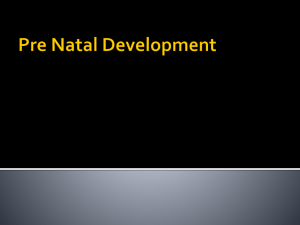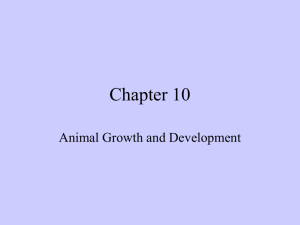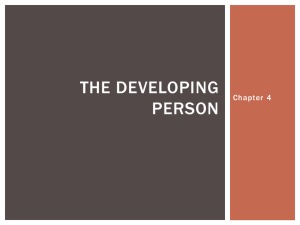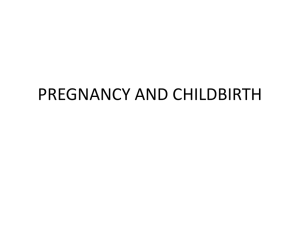Ectoderm
advertisement
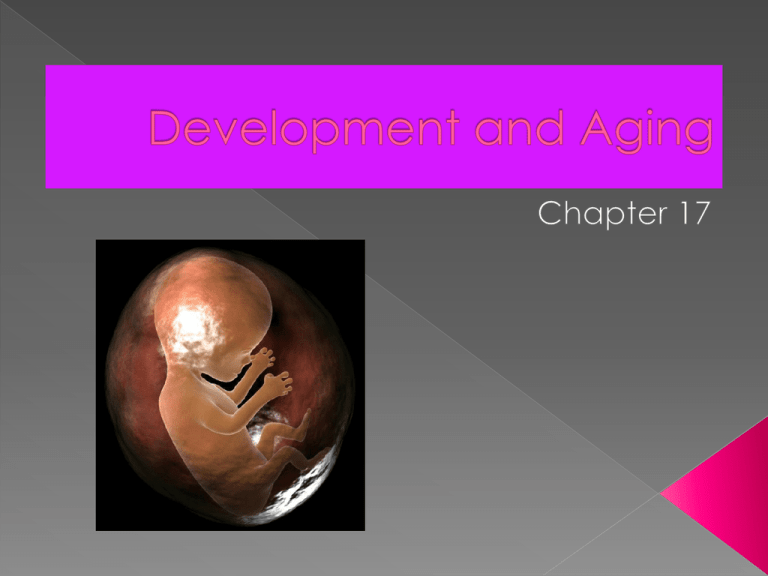
Focus: Like all animals, humans begin life as a single cell from which tissues and organs soon begin to develop. Cleavage: zygote undergoing cell divisions Morula: cluster of sixteen cells › Each cell called a blastomere Gets a different portion of the cytoplasm Helps determine the fate of the cells to come later Gastrulation › Rearranges the morula’s cells to form… Germ layers; three primary tissues 1. Ectoderm 2. Mesoderm 3. Endoderm Cell differentiation › Process of cell specialization › Begins in the germ layers › Different genetic instructions (genes) operate in different cells Adults have ~200 differentiated cell types Morphogenesis: › Tissues and organs formation › Cell division in certain areas of gastrula › Movement of cells and tissues within gastrula › Folding of tissues into organs › Death of certain cells Focus: A newly formed embryo cannot survive unless it implants in the mother’s uterus. Fluid-filled cavity forms in the morula → blastocyst › Two tissues Trophoblast Inner cell mass: forms the embryo Identical twins › Split usually during first cleavage or the inner cell mass Fraternal twins Implantation › Begins ~one week after fertilization; › › › › completed two weeks after ovulation Blastocyst breaks out of zona pellucida Epithelial cells invade endometrium → cross into connective tissue of uterus Endometrium covers blastocyst Blastocyst secretes HCG human chorionic gonadotropin Focus: The embryonic period lasts for eight weeks. During that time, the basic body plan of the embryo takes shape. Embryonic disk › Primitive streak along axis and thickening of cells marks gastrulation Ectoderm thickens and forms a neural tube › Forerunner of brain and spinal cord › Notochord; vertebral column forms around it Mesoderm gives rise to somites › Gives rise to most bones and muscles › Coelom forms from spaces (body cavities) Neurulation: › Development of the nervous system from ectoderm Cells move from place to place with chemical cues Adhesive cues stop their movement Apoptosis: programmed cell death Focus: During implantation and over the next few weeks, four specialized membranes form outside the embryo. These membranes include the allimportant placenta. Certain cells of the embryonic disk give rise to the extra-embryonic membranes 1. Yolk sac 2. Amnion 3. Allantois gives rise to blood vessels that invade the umbilical cord 4. Chorion Placenta › Organ formed from chorion and upper cells of the endometrium › Chorionic villi contain small blood vessels › Site of exchange of nutrients and wastes What other maternal substances can cross the placenta? › Alcohol, caffeine, drugs, pesticide residues, toxins in cigarette smoke, and HIV Focus: By the end of four weeks, the embryo has grown to 500 times its original size. Over the next several weeks it will develop recognizable human features. Rapid growth and cell specialization Umbilical cord forms; head region grows faster; gonads develop After eight weeks, embryo → fetus › Heart beating; genitals well-formed Miscarriage › Spontaneous expulsion of embryo or fetus Focus: In the second and third trimesters, organs and organ systems gradually mature in preparation for birth. Fetus at three months › 4.5 inches long › Reddish skin Fetus at four to six months › Facial muscles produce frowning, squinting, and sucking movements › Movement of fetus felt by mother › Eyelids and eyelashes form Fetus from seven months to birth › 11 inches at seven months › Organ systems maturing › Fetuses born between 23–25 weeks will need intensive care Respiratory distress syndrome › Premature infants at risk › Lungs lack surfactant; can’t expand adequately Umbilical cord vessels › Two arteries transport deoxygenated blood and waste to placenta › One vein brings oxygenated blood and nutrients to fetus Fetal lungs bypassed with blood moving through the foramen ovale and the arterial duct Fetal liver bypassed using the venous duct Modifications occur at birth Normal Focus: Birth, or parturition, takes place about 39 weeks after fertilization—about 280 days from the start of the women’s last menstrual period. Fetal organs (hypothalamus, pituitary, and adrenal glands) produce hormones › Indirectly cause mother’s uterus to contract Hormones cause placenta to produce more estrogen › Triggers oxytocin and prostaglandins to be produced › Stronger uterine contractions Labor length varies First stage › Contractions push fetus against cervix, which dilates to 10 cm; usually amniotic sac ruptures Second stage › Very strong contractions; baby delivers head first › “Bottom-first” or breech delivery; complications Third Stage › Placenta forced out of the mother › Baby’s first breath Video Estrogen and progesterone during pregnancy › Growth of mammary glands and ducts › Colostrum produced initially Prolactin › Stimulates milk production › lactation Oxytocin › Regulates flow of milk › Reflex; positive feedback control Focus: From fertilization until birth, a woman’s future child is at the mercy of her diet and lifestyle. Pregnant women should: › Follow a healthy diet › Take supplemental vitamins and minerals Folic acid important for neural tube development: spina bifida exposure of spinal cord in utero › Gain between 20–35 pounds Pregnant woman’s IgG antibodies cross the placenta › Protects fetus against many infections Teratogens › Agents that cause serious birth defects Example: Rubella (German measles) › Serious birth defects during first trimester › Mother should be vaccinated to avoid this threat Fetus most susceptible during the first trimester Tranquilizers › Thalidomide: 1960s; caused missing or deformed limbs Some sedatives and barbiturates › Similar but less severe damage Anti-acne drugs › Increased risk of facial and cranial deformities Antibiotics › Streptomycin Hearing problems; may affect the nervous system › Tetracycline Child may develop yellowed teeth Alcohol › Fetal alcohol syndrome Many defects: smaller brain and head, facial deformities, poor motor coordination, heart defects Cocaine, especially crack › Improper nervous system development Tobacco smoke › Great risk of miscarriage, stillbirth, and premature delivery › Underweight › Less vitamin C in blood › Effect of secondhand smoke still unknown 1. Chorionic villus sampling (CVS) › Removes sample of chorionic cells by suction 2. Amniocentesis › Samples fluid from the amnion 3. Preimplantation diagnosis › Uses recombinant DNA technology 4. Fetoscopy › Uses sound waves Focus: After a child enters the world, a gene-dictated course of further growth and development leads to adulthood. 1. 2. Newborn and infancy Childhood and adolescence › › 3. Puberty: arrival of sexual maturity Growth stops by early twenties Adult and old age Senescence › Body parts and functioning begin to deteriorate after age 40 Average life expectancy in the United States › Males: 74 › Females: 79 Focus: Time takes a toll on body tissues and organs. To some extent, our genes determine how long each of us will live. Consistency of lifespan within a species Most human cells divide between 80–90 times: › Chromosomes capped with segments of DNA called telomeres These shorten with each cell division Cancer cells and cells in gonads that give rise to sperm and oocytes: › Produce an enzyme that lengthens the telomere › These cells can divide over and over Aging probably involves many factors including: › Genes › Free radical damage › Decline in DNA repair mechanisms Aging: gradual loss of vitality › Cells, tissues, and organs function less and less efficiently Skin: thinner, collagen more rigid, less elasticity, drier, less hair, graying of hair Muscles: loss mass and strength; lost muscle replaced with fat Bones: osteoporosis and osteoarthritis Lungs › Walls of alveoli break down; less surface area for gas exchange Heart › Slightly enlarged; less-efficient pump Blood transport › Vessels become stiffer › Cholesterol plaques narrow the vessels Immune system › T cell numbers fall; B cells become less active › Autoimmune response increase Digestive tract › Mucus glands in the lining break down › Pancreas secretes fewer digestive enzymes › Basal metabolic rate decreases Hormones: most keep steady levels; sex hormones are the exception Brain neurons die throughout life brain shrinks Aged brain › Neurofibrillary tangles: may disrupt normal cell operations › Beta amyloid forms: clotlike plaques between neurons Sensory organs and taste buds › Less efficient over time Alzheimer’s disease › Physiology Masses of neurofibrillary tangles riddled with beta amyloid plaques › Symptoms Progressive memory loss Disruptive changes to personality › Causes Some are genetic › Treatments Limited; may slow progression
